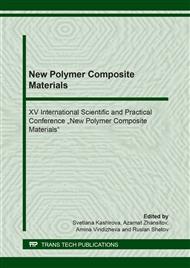[1]
A. Ulman. An Introduction to Ultrathin Organic Films: From Langmuir-Blodgett to Self-Assembly, Academic Press, New York, (1991).
DOI: 10.1002/ange.19921040445
Google Scholar
[2]
A. Bruno. Controlled Radical (Co)polymerization of Fluoromonomers. Macromolecules. 43 (2010) 10163–10184.
DOI: 10.1021/ma1019297
Google Scholar
[3]
G. Moad, E. Rizzardo, S. H. Thang. Living Radical Polymerization by the RAFT Process—A First Update. Aust. J. Chem. 59 (2006) 669–692.
DOI: 10.1071/ch06250
Google Scholar
[4]
G. Wen. Network Structure Control of Binary Mixed Langmuir Monolayers of Homo-PS and PS-b-P2VP, J. Phys. Chem.B114 (2010) 3827–3832.
DOI: 10.1021/jp909588p
Google Scholar
[5]
D. V. Vishnevetskii, A. V. Plutalova, V. V. Yulusov, O. S. Zotova, E. V. Chernikova, S. D. Zaitsev. Controlled radical copolymerization of styrene with acrylic acid and tert-butyl acrylate under conditions of reversible addition-fragmentation chain transfer: Control of the chain microstructure, Polymer Science Series B. 57 (2015) 197–206.
DOI: 10.1134/s1560090415030094
Google Scholar
[6]
E. V. Chernikova, S. D. Zaitsev, A. V. Plutalova, K. O. Mineeva, O. S. Zotova, D. V. Vishnevetsky. Control over the relative reactivities of monomers in RAFT copolymerization of styrene and acrylic acid, RSC Advanced. 8 (2018) 14300–14310.
DOI: 10.1039/c8ra00048d
Google Scholar
[7]
O. Borisova, L. Billon, M. Zaremski, B. Grassl, Z. Bakaeva, A. Lapp, P. Stepanek, O. Borisov. Synthesis and pH- and salinity-controlled self-assembly of novel amphiphilic block-gradient copolymers of styrene and acrylic acid, Soft Matter. 29 (2012) 7649-7659.
DOI: 10.1039/c2sm25625h
Google Scholar
[8]
O. Borisova, M. Zaremski, O. Borisov, L. Billon. The WelllDefinedBootStrap Effect in the MacroinitiatorrMediatedPseudoliving Radical Copolymerization of Styrene and Acrylic Acid, Polymer Science Series B. 55 (2013) 11–12.
DOI: 10.1134/s1560090413090017
Google Scholar
[9]
T. S.C. Pai, C. Barner-Kowollik, T. P. Davis, M. H. Stenzel. Synthesis of amphiphilic block copolymers based on poly(dimethylsiloxane) via fragmentation chain transfer (RAFT) polymerization, Polymer. 45 (2004) 4383–4389.
DOI: 10.1016/j.polymer.2004.04.041
Google Scholar
[10]
Y. Wang, G. Wen, S. Pispas, S. Yang, K. Youa. Effects of subphase pH, temperature and ionic strength on the aggregation behavior of PnBA-b-PAA at the air/water interface, Journal of Colloid and Interface Science. 512 (2018) 862–870.
DOI: 10.1016/j.jcis.2017.11.002
Google Scholar


